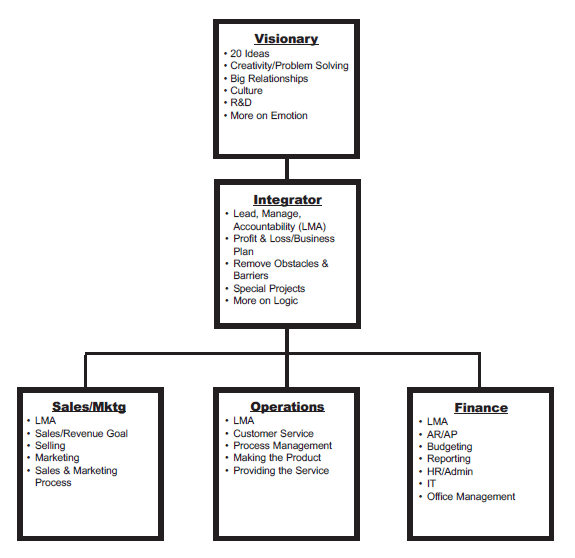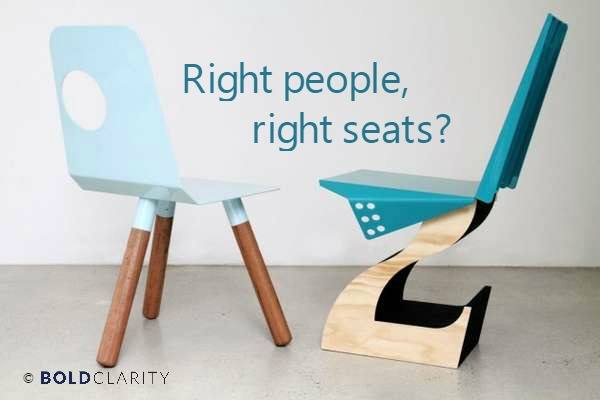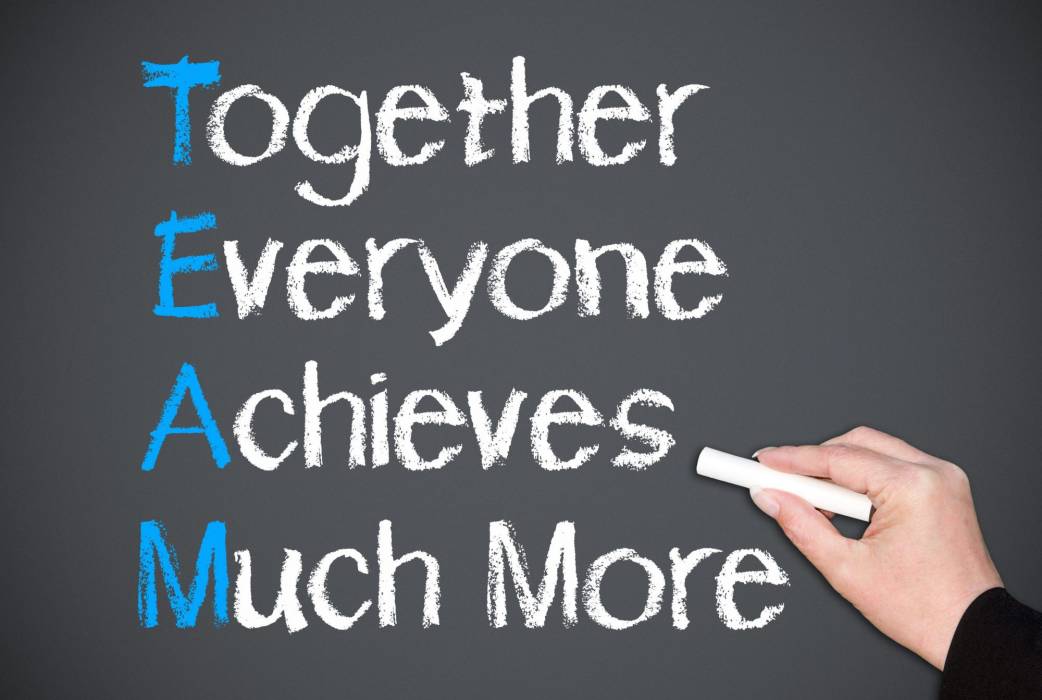Building a healthy team – and a great team culture – are two of the most important factors in business success.
Having run businesses for the past 20 years – both before and after I became an Entrepreneurial Operating System Implementer – I know the value of ensuring you have the right people, in the right role, all working towards the same goal.
A key element of EOS is to create a healthy, cohesive leadership team, and the “People” element of the system focuses on making sure you employ people who share your vision and are going to help your business to thrive.
In this guide, we are offering our advice about to how to structure and develop a healthy team the EOS way, using the tools and techniques it provides.
VIDEO: DISCOVER THE VALUE OF RUNNING YOUR BUSINESS USING EOS
We will be drawing on my years of experience as an employer to examine how to decide what roles you need to fill, explore best practice in the hiring process, discuss how to build a positive team culture and advise on the best way to give feedback.
Throughout, we’ll offer links to articles, case studies and videos which take a deeper dive different elements of creating a healthy team.
Quick links
- Your business: structure first, people second
- EOS HR tools: do you have the right people?
- Using EOS tools to build a healthy team
- How to design your hiring process
- How to interview so you hire the right talent
- How to build healthy team culture in your business
- Using a scorecard to track employee performance
- How to give employee feedback
- Aligning and communicating your vision to your team
1. Your business: structure first, people second
People are your most valuable business resource.
You can have the best idea, product or service; you can be well funded, have great cash flow and be positioned in the right market. However, if you don’t have the right people, you’re won’t make your vision come true.
Your people need to match your core values, have the right skills and have the right attitude.
In order to make sure you’ve got the “right people in the right seats”, you need the right structure for your business.
A fundamental tool of the Entrepreneurial Operating System™ (EOS) is have an Accountability Chart.

Three major functions
We believe three major functions make every business work:
- Sales and marketing(how you sell and market the product)
- Operations(manufacturing and delivering your product or service)
- Finance(which also includes administration and it)
The EOS accountability chart has a box for each of these three functions.
The Integrator
Above the three major functions there is an Integrator.
He or she is the person who seamlessly makes the three core functions work together, removing obstacles and solving problems so that the whole company can function and thrive.
The Integrator is responsible for the bottom line, profit and loss and making sure the company is moving forward and eliminating any problems.
The Visionary
About half the time, there is also a second role, the Visionary, positioned in a box above the Integrator.
The Visionary is the spirited entrepreneur who comes up with great ideas, is in charge of the big relationships and is the spokesperson for the business. They are responsible for the culture, the passion, the vision.
Sometimes the Visionary is not a strong “completer finisher” and they are typically not good at executing and implementing over a long period of time.
If you have a strong Visionary, you will need to put in place an Integrator as your business grows, to seamlessly integrate all the working parts and execute on the company’s vision.
These five core roles make up your leadership team.
Responsibilities
Each of the five roles has five things they must be responsible for delivering.
This allows each role to understand exactly where they fit in the organisation, their key responsibilities, and what they must get done in order to be successful.
Even if you are a solo entrepreneur, you still need an Accountability Chart.
In the beginning you wear all the hats and execute on all the roles. As you grow, the Chart gives you a clear picture of who you need, when, in the organisation.
These roles do not have to be a full-time employee. They can be outsourced to specialists, so your business receives quality and expertise without the full-time positions.
The beauty of the EOS Accountability Chart is that as your business grows, it simply grows with it.
Having the right structure in place, will enable you to find the right people and place them in the right seats.
2. EOS HR tools: do you have the right people?

You have a great business, great market share and good cash flow.
But if you don’t have the right people, in the right seats, you won’t be successful.
You can’t have a good business without good people, whether they are your employees or outsourced.
And if your vision for your business is not shared by your team, it will take longer to achieve that vision – and you risk it not happening.
To avoid this, you need a system and process that everyone follows that actively creates a healthy team.
Your process should include:
- A screening procedure to match candidates values to the company’s core values
- Screening candidates to ensure their skills and experience match the role
- An accountability chart clarifying each person’s role and responsibilities
- Setting goals for each team member with measurables and completion date
- A scorecard which tracks what they have achieved on a weekly basis
- Regular meetings to review, reward and recognise the team
- An annual review to assess achievements, productivity and set next year’s goals
Putting in place these HR tools and a system will help ensure you don’t waste money, time, energy and resources on hiring the wrong people.
EOS puts in place processes which will ensure that everyone in your company understands your vision, wants to make it happen – and has the ability to do so.
Now we are going to go into more depth about the EOS tools that will help you employ the right people.
3. Using EOS tools to build a healthy team
Business owners and leaders adopt the Entrepreneurial Operating System (EOS) when they want to overcome business challenges and successfully grow their company.
By following the EOS framework, you will be able to manage and plan for every obstacle in the way of your business success.
One of the key facets of EOS is hiring the right people and how building a healthy team can have a positive impact on your company’s ability to achieve its goals.
In order to achieve your vision, you have to recruit great people. Hiring a team which embodies your values is essential.

To ensure this, you can use the EOS People Analyser™, to help you make the right hiring decisions each time.
Every company’s core values are unique. The People Analyser allows you to cut through the complex layers of interviewing someone and find out if they embody your company values and characteristics.
When you interview candidates around their core values and delve into their drivers, passions and goals, you can determine whether they are aligned with your business.
Hiring the right team
When using the People Analyser, you write your company core values at the top, and your team members names down the left side, and you evaluate whether or not they meet or match the value.
We use + if they do it most of the time, +/- if they do it some of the time and – if they don’t do it most of the time.
As an example, when a company has five core values, the recommended bar is three +s and two +/-s, never a minus.
Candidates who are at or above the bar match the company values and you want to get 100% of the right people in your organisation.
As Jim Collins said: “a great vision without great people is irrelevant,” – you need to be sure you’re recruiting the best people into your company.
A healthy team should: Get it, Want it, the Capacity to do it
The next stage of the people analyser is to use your completed Accountability Chart and to clarify who is responsible for what role.
Then it is time to put the people who match your core values into the right seat. We use “GWC” as a filter. G = get it, w = want it and c = the capacity to do the job.
It is a yes or no answer to these questions.
Get it – means they truly understand their role, the culture, systems and process, and how the job comes together.
Want it – means they are motivated to take the responsibility and do the job, based on fair compensation
Capacity – means they have the time and the mental, physical and emotional capacity to do the job well.
For this section of the People Analyser, you must have three yes’s.
The People Analyser is just one tool in the EOS framework to help you establish the critical success factors you need to grow your business in the direction you envision.
4. How to design your hiring process
Hiring the right staff is one of your most important tasks – if you don’t have the right people in the right seats, it can have a real impact on success of your business.
It is important to hire people who share the vision and culture of your business.
Here, our Integrator Majida Burch, describes the steps we take to make sure we hire staff who meet our vision and values.
Identify your market
There is no point in wasting time and effort advertising in places which are unsuitable for your target market.
It is important to identify the best places to advertise before you start your search. The best way to do this is to consider the role and the type of candidates who would be most suitable.
As part of our process of looking for a freelance office assistant, we identified that the most relevant market would be mothers looking to return to work and had previous office experience, so we found places to advertise where these groups would search.
Engaging advert
If you want to guarantee you get a good response to your advert, take some time to ensure your advert is engaging.
An effective job advert will help you to encourage applicants and to enable you to reach the right people as quickly as possible. This will make the hiring process much easier in the long run.
With a small budget, we found that using Timewise Jobs was effective. We received over 130 applicants for our role.
Responsive
You need to respond quickly because good applicants will be snapped up in a week or two.
And do respond to all candidates, whether you are taking them forward or not.
If you don’t reply to candidates it can damage the reputation of your business.
Screening process
With 130 candidates, we needed a highly effective screening process to identify the right person for the job.
Our customised recruitment process had seven stages, and at each stage we filtered out those who didn’t meet our criteria.
- A “request for further information”
- Phone screening
- Competency testing
- A peer interview
- Kolbe testing
- An interview with the CEO Julia
- References
We then offered the most suitable candidate a paid trial to see how they worked, and then finally an offer.
Our criteria for success included:
- A well written and non-generic cover letter, ideally referring to our company and area of business
- Bonus points given if they address any of the person specification/requirements within the cover letter
- A well formatted CV
- Speed of response to request for additional information
- Good customer service skills, who was enjoyed managing up and had a tenacious, “get things done personality”
The way our process was designed enabled us to automatically filter out candidates at each stage, so, of example, if they answered no to the question about having previous office experience, they would not progress to the next stage.

5. How to interview so you hire the right talent
One of the questions my clients ask me is how can they attract and hire the right talent – ie people.
I believe finding the right talent starts with having a defined process and system, both in your hiring process, and to help you be great at the interview stage.
How to interview potential staff
One of the books I use and recommend is Who, by Geoff Smart and Randy Street, which provides a successful method of hiring.
I use their “who” interview worksheets. Having a template, has made me a better interviewer, with a more consistent approach – plus I ask smarter questions.
One of the challenges with interviewing without this preparation is that you ask different questions to different candidates, making it harder to evaluate and compare.
A second challenge if I am not using a template is that I often ask leading questions, so the interviewee tells me what I want to hear, rather than their true answer.
Then, once you hire them, you discover not the person you thought you were hiring. And it’s your fault.
Using the “Who” worksheets means my interviews are consistent.
Here are a few additional ways to make sure you are interviewing to hire the best candidate.
Asking the right interview questions
- In the interview, I like to create a conversation and get the candidate in the mode answering a question and giving me an example how.
I find candidates are extremely candid and honest if you have a system and a set of specific questions.
- I create interview questions around the core values of my company without telling the candidate what my core values are.
As an example, I was interviewing a woman for a part-time office role. She was a stay-at-home mum wanting to return to work. I asked her to give me an example of when she said she was going to do something, and followed through and did it.
Much to my surprise, she said, oh, I never to that. I always tell my friends that I am going to meet them for a coffee and then cancel at the last minute.
Needless to say, I didn’t hire her.
- Another question I find effective in interviews is to ask the candidate on a scale of 1-10 how much they want this position. If the answer is not 10 I am hesitant to hire them.
I want them to be self-motivated and excited to take the position – after all, they will never be as motivated as when they first take the position.
- Once I have found the candidate I think fits both my company core values and the skill-set I am looking for, I require them to come in for an eight-hour on the job trial.
We happily compensate them for the day they have to take off from their existing role. It is telling how much a person wants a job if they are willing to take a day’s holiday and trial both for them and for you.
Conclusion
Interviewing based on your core values, and ensuring your questions are consistent by basing them on a template, will help you ensure you hire the right people who want to work well and help your business to grow.
6. How to build healthy team culture in your business
 Once you have your team in place, building a good culture in your business is essential. It can be the difference between success or failure, stagnation or growth.
Once you have your team in place, building a good culture in your business is essential. It can be the difference between success or failure, stagnation or growth.
When I founded my first business, Retail Profile (now Pop Retail), we started small.
Despite this, we consistently doubled the size of our business without growing the size of our team.
This was because we consciously set out to build an amazing team culture that made sure everyone fitted in, felt involved, felt valued and everyone shared the company vision.
Every quarter, we would take the entire team, from the maintenance guys up to the MD, out of the business for a one-day quarterly meeting. Some companies call this a state of the company meeting, or town hall meeting.
VIDEO: HOW TO BUILD A POSITIVE TEAM CULTURE
At this meeting, we would examine our numbers, review our budget vs actual numbers and discuss any variances that were off. This gave us a have a clear picture of where we are so we could discuss the plan for the next 90 days and the growth of the business.
We would then use the rest of the day to eat together and do team building.
We did everything from rounders to boating on the Serpentine to barbequing to profiling each person in the company – and once we even went camping.
Sharing these activities meant that we bonded, knew and understood each other, and as a result were able to work together better as a team.
After this quarterly meeting, everyone would understand the company’s financial position, knew where we were headed and how we were going to get there.
EOS people tools
Without realizing it, I was practising one of the key tools of the Entrepreneurial Operating System
Now I run my current business Bold Clarity on EOS – as well as working as an EOS Implementer, helping other leadership teams to scale and grow. We make sure that the vision and values of the business are understood and shared by the entire team.
In addition to our quarterly meeting, which we still hold, we also have weekly meetings to make sure all our numbers are on track, everybody is on the same page and to prioritise the most important issues to discuss and solve.
READ MORE: HOW TO RUN A GOOD MEETING
8. Using a scorecard to track employee performance

Are you flying your business blind or do you use data to manage it? Do you have a handful of numbers that tell you at a glance how your business is doing?
Some people use monthly financial documents or profit and loss statements (P & L) to manage their business – a trailing indicator and after the fact.
Using a scorecard, as we do in the Entrepreneurial Operating System, allows you to manage the future.
What is a scorecard?
A scorecard measures activity-based weekly numbers for each team member. These might include: weekly revenue, closed business, customer satisfaction, capacity, sales meetings or cash in the bank.
How does using a scorecard help you develop a healthy team
Managers are human – which means they can be subjective. When you use a scorecard to track an employee’s true performance, it cuts out egos, personalities, subjectivities, stories and measures real results.
It allows your team to manage themselves and gives a fairer, more objective view on performance. It helps track results and keeps a finger on the pulse of what is really happening in a business.
It provides an early warning system of potential problems or gaps in performance, so you can correct and make changes that are needed to get back on track.
How do you get started using scorecards?
What if you could measure your entire company using 14 numbers?
The EOS scorecard uses activity-based numbers, customised to each department.
This helps predict on a weekly basis, 52 times a year, what is really happening in your business. The numbers are reviewed at the weekly 90 minute meeting.
How do team members react to using a scorecard?
At Bold Clarity, we’ve found using the scorecard helps team members understand how they contribute to the big picture, see their own performance clearly and take responsibility for the measurement.
We review our scorecards every Monday and it has become system and routine we rely on. It helps keep us on our toes as we know we have to report to each other what we have achieved over the last seven days.
The scorecard is unilateral. Everyone has a number, from top to bottom, so everyone accountable – including the ceo and managing director.
CASE STUDY: HOW ONE TEAM REACTED WHEN THEIR COMPANY INTRODUCED EOS AND THE SCORECARD
Do team members ever feel threatened by it?
A person who doesn’t want to be measured is possibly someone who doesn’t want to do the work.
If someone is the right person, matches the business’s core values, and has the ability to perform, then they are happy to be measured on a scorecard. It tracks what needs to get done. In a healthy team, everyone should welcome the transparency of the scorecard, where everyone knows who is working and who is not.
What has been the impact of using the scorecard at Bold Clarity?
Since we’ve been using the scorecard in our business, team awareness has significantly increased. We can clearly see what is getting done and what is not. This means we are able to prioritise how we use our time according to the gaps in the scorecard.
It means that with just a handful of numbers, you can tell at a glance how your business is doing.
READ MORE:THE VALUE OF SETTING TARGETS IN YOUR BUSINESS
9. How to give employee feedback
You want your business to be the best. That means getting the best from every employee and ensuring they all work towards the same common goal of taking your company to the next level.
As a UK-based Certified EOS Implementer, I’m often asked the same question: how do I ensure my employees are motivated and efficient. I believe it is one of our most important jobs as leaders and managers.
People want feedback, they want to do a good job, to know it, and to be recognised and rewarded when they do.
Often their number one complaint is that they don’t know how well they are performing, and that they’ve been thrown out there on their own, to get on with it with no feedback.
So it’s important that they know when they are doing good work, and the standard you want them to maintain.
The most effective way to give employee feedback is to praise in public and criticise in private.
Giving praise

If your employees are doing a great job, let them know!
Sometimes it is not just about money. It is about being told they’re doing a good job by their leader 1-2-1 and being praised in front of their peers.
This creates a standard for the department, as everyone knows what a good job looks like.
When giving employee feedback, be as specific as possible. Don’t just tell people that john is doing a great job today. Describe what he’s done in detail and the outcome and positive impact on the business.
Praising in public is also great for showing your employees that you care and support the work they’re doing.
Giving criticism
Sometimes we get things wrong, make mistakes or just aren’t performing our best. It happens. The important thing is to make sure that your employees understand where they went wrong, where they’re not reaching the required level and learn how to improve.
First of all, make sure your feedback is given in private. If you were to do this publicly, it is not fair to the employee or the team. More importantly, giving employee feedback in private allows you to take a more personal and constructive approach.
This is not about criticising, it is a way of offering constructive feedback about poor performance.
The best approach is to make it about the task, not the person. Tell them your expectation, explain where the performance didn’t meet the standard, and give three specific, detailed examples.
Stay calm and controlled, with a good tone of voice. This is your chance to give guidance on what is expected and a timetable for improvement.
How does it work?
A simple example is when you train animals.
My mother took her two-year-old mare star to be trained by an expert horse trainer.
The trainer gave star a lot of praise when she did well, but immediate feedback when she did something wrong.
The positive praise made star feel at ease, encouraging her to continue doing the same actions and behaviours that the trainer wanted.
When star did something wrong, the trainer would snap the bridle. This didn’t hurt star. It just made her uncomfortable. So, she knew straight away that something was wrong and she therefore had to change her behaviour.
Within 30 minutes, star was behaving and progressing excellently, showing the immediate results of this approach.
This is the same thinking behind the praise in public and criticise in private method. It gives you a chance to clearly communicate to your employees what they are doing right and wrong.
Praise in public, criticise in private
By providing employee feedback where it matters, this method allows your team to quickly learn what work and behaviour is acceptable – and what isn’t.
Overall, this leadership method is perfect for encouraging better and more productive work from your employees.
10. How do you align and communicate your vision to your team?

In order to take a company to the next level, most businesses will need to continually evolving their vision.
Your business may have outgrown your initial plans and become more complex as it has grown.
If you have a healthy team culture, they will take on board your vision as it changes. These three key points will help you communicate your evolving vision.
1) Live the vision
Your team will want to see you leading by example.
Words will only get you so far when it comes to changing the direction or focus of your company.
“do as I do, not as I say” – the leader and the leadership team needs to walk the talk. As goes the leadership team, so goes the whole company.
Your decisions, your language and your vision will be adopted by the rest of your team.
CASE STUDY: HOW ONE COMPANY GOT THEIR WHOLE TEAM ON BOARD WITH EOS
2) Evolve your vision
For any business to survive, it needs to be adaptable and flexible.
Market conditions change, competition increases, and this may have an impact on your vision.
There may well be parts of it which sound great on paper, but you’re are not able to implement either in the time-scale or way that you expected.
Be prepared to adapt the plans as you go along. Having regular “state-of-the-company” or “all-hands-meetings” every 90 days will help you to communicate the vision and hear valid concerns and feedback from your customer facing team, which is working on the front line.
Strong leaders are open to change and respond well to input from their teams. Receiving feedback is a part of getting everybody aligned and coming up with the best solutions for the organisation to execute on their vision.
READ MORE: HOW TO CRYSTALLISE YOUR VISION USING THE VISION/TRACTION ORGANISER
3) Execute the vision
Don’t underestimate the problem-solving capabilities of your leadership team.
The great thing about having other people on board is that they too have shared knowledge and understanding of your business. Once you’ve recruited the right leaders in your team, use them as a resource to identify, discuss and solve the issues the business faces. Raise these at your weekly team meetings.
Involving them in solutions gets more buy-in and helps create a healthy team culture. They’ll solve problems faster, as they’re the ones who will need to carry out the actions and to dos.
READ MORE: HOW TO IDENTIFY, DISCUSS AND SOLVE YOUR ISSUES
Without a strong vision, you may have people working against where you want to take your company. Overall, you need a strong vision lived by the leaders, evolved on a constant basis, and communicated and aligned with the whole organisation.
And finally – creating a healthy team
Building a healthy team which shares your vision is crucial to the success of your business. Using the EOS tools helps you put in place processes and systems to make hiring talent, ensuring they share and execute your vision, and that you build a positive culture far easier.

